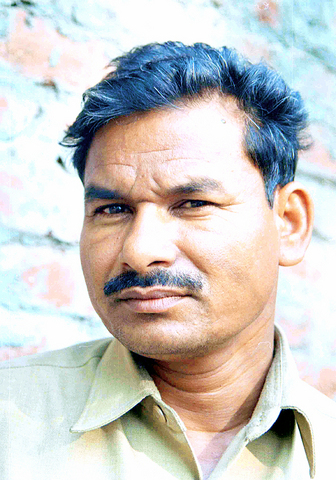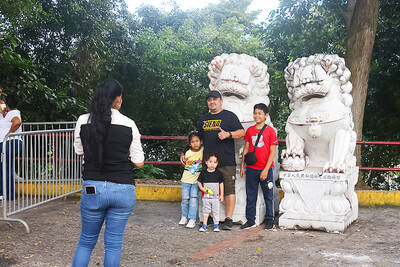Lal Bihari made countless rounds of police and government offices, but to no avail. Finally he decided to contest elections to draw attention to his problem: He had been declared officially dead.
It took Bihari 16 years to get the government to recognize that he was in fact still alive. Relatives had him falsely proclaimed dead in order to seize his property.
Bihari, who still adds "late" or mritak before his name, is today fighting an even tougher battle -- to get a life for an estimated 40,000 "dead" people in his home state of Uttar Pradesh.

PHOTO: AFP
He founded the Mritak Sangh, or the Association of the Dead, four years ago in an effort to restore dignity to so many blighted lives and to seek compensation from the northern state government for maintaining false records.
The fight is not easy. The victims face the same corruption and indifference which led to their plight in the first case and, deprived of all their possessions, no longer have any resources for legal action.
"I myself had gone to government officials to tell them I am alive. I went to police stations, to revenue courts and even met politicians with the only request to recognize me as a living person," Bihari says.
He says he was declared dead in 1984 by revenue officials in Azamgarh, 300km southeast of Uttar Pradesh state capital Lucknow, after his uncle connived with officials to grab his property.
He discovered his administrative status as dead when he went to officials to try to find out how his uncle had managed to get 16 acres of Bahari's land transferred into his own name.
Bihari employed novel ways to get his name on official records, notably by picking fights so that the police would file a complaint against him ensuring his name entered police files.
But he says the police quickly saw through his gameplan and refused to register cases against him. After much frustration, Bihari hit on the idea of standing for election to draw attention to his misery.
"I contested two elections to tell the world that I am alive and not dead. I lost both the elections but won the bigger battle," he says.
After a 16-year court battle Bihari finally got his true status back in 2000. He is still demanding 200 million rupees (US$5 million) in compensation from the government for his years of torment.
Others such as Mahboob Hasan, 68, who found out he had "died" in 1991, have been less fortunate.
"My son grabbed my property by producing a fake death certificate. I have met officials but the government still refuses to recognize me as alive," he said. "The village head has recognized me as alive, but the revenue officials still consider me a dead man."
The former schoolteacher says even the state chief minister was aghast to hear of his story about how his son sold off the property and migrated to the Gulf trading and tourism hub of Dubai.
Victims such as Hasan are rendered homeless when their property is taken over by relatives, who often pay as little as 50 rupees (about US$1) or a bottle of liquor to obtain a fake death certificate from a corrupt minor official.
"They feel deceived by their loved ones. They are poor and do not have enough money to get a square meal a day, forget about filing court cases," says lawyer S.K. Mishra, who has represented several living dead people in the court.
The state's revenue minister said the government was aware of the issue and working to solve it.

Shamans in Peru on Monday gathered for an annual New Year’s ritual where they made predictions for the year to come, including illness for US President Donald Trump and the downfall of Venezuelan President Nicolas Maduro. “The United States should prepare itself because Donald Trump will fall seriously ill,” Juan de Dios Garcia proclaimed as he gathered with other shamans on a beach in southern Lima, dressed in traditional Andean ponchos and headdresses, and sprinkling flowers on the sand. The shamans carried large posters of world leaders, over which they crossed swords and burned incense, some of which they stomped on. In this

Near the entrance to the Panama Canal, a monument to China’s contributions to the interoceanic waterway was torn down on Saturday night by order of local authorities. The move comes as US President Donald Trump has made threats in the past few months to retake control of the canal, claiming Beijing has too much influence in its operations. In a surprising move that has been criticized by leaders in Panama and China, the mayor’s office of the locality of Arraijan ordered the demolition of the monument built in 2004 to symbolize friendship between the countries. The mayor’s office said in

‘TRUMP’S LONG GAME’: Minnesota Governor Tim Walz said that while fraud was a serious issue, the US president was politicizing it to defund programs for Minnesotans US President Donald Trump’s administration on Tuesday said it was auditing immigration cases involving US citizens of Somalian origin to detect fraud that could lead to denaturalization, or revocation of citizenship, while also announcing a freeze of childcare funds to Minnesota and demanding an audit of some daycare centers. “Under US law, if an individual procures citizenship on a fraudulent basis, that is grounds for denaturalization,” US Department of Homeland Security Assistant Secretary Tricia McLaughlin said in a statement. Denaturalization cases are rare and can take years. About 11 cases were pursued per year between 1990 and 2017, the Immigrant Legal Resource

‘RADICALLY DIFFERENT’: The Kremlin said no accord would be reached if the new deal with Kyiv’s input did not remain within the limits fixed by the US and Russia in August Ukrainian President Volodymyr Zelenskiy is to meet US President Donald Trump in Florida this weekend, but Russia on Friday accused him and his EU backers of seeking to “torpedo” a US-brokered plan to stop the fighting. Today’s meeting to discuss new peace proposals comes amidst Trump’s intensified efforts to broker an agreement on Europe’s worst conflict since World War II. The latest plan is a 20-point proposal that would freeze the war on its current front line, but open the door for Ukraine to pull back troops from the east, where demilitarized buffer zones could be created, according to details revealed by